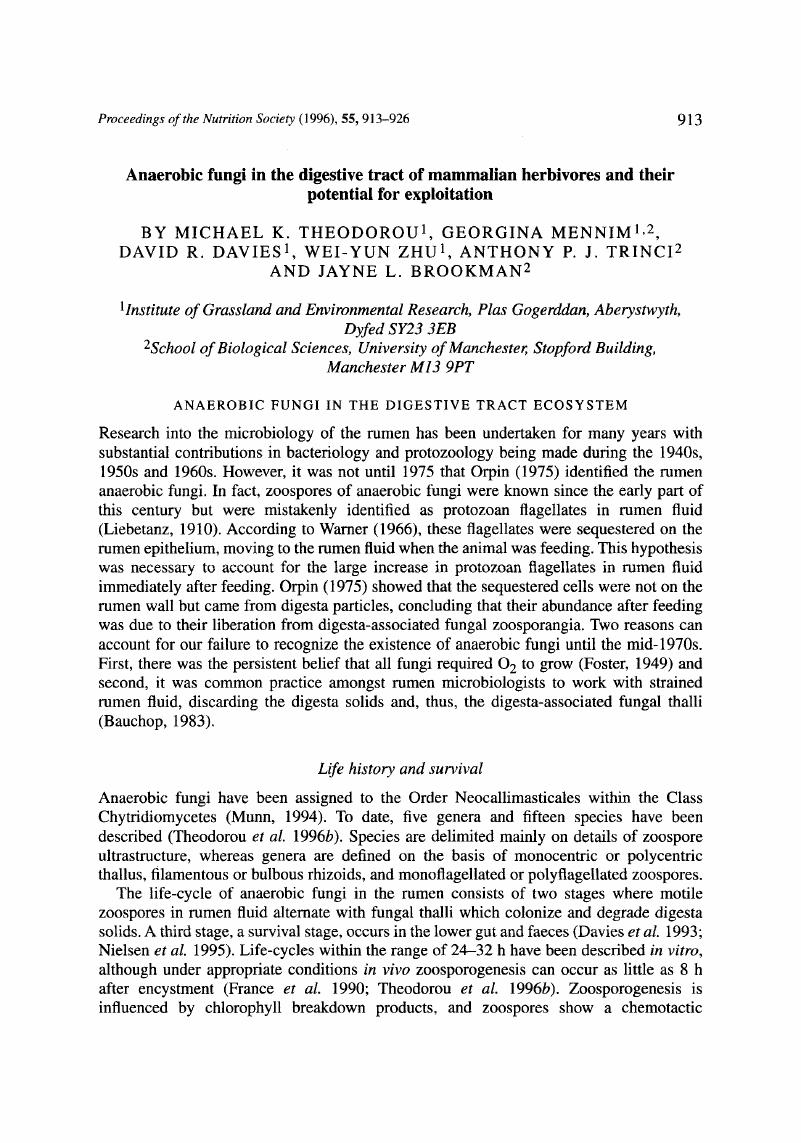Crossref Citations
This article has been cited by the following publications. This list is generated based on data provided by Crossref.
Cheng, Yan Fen
Jin, Wei
Mao, Sheng Yong
and
Zhu, Wei-Yun
1970.
Production of Citrate by Anaerobic Fungi in the Presence of Co-culture Methanogens as Revealed by 1H NMR Spectrometry.
Asian-Australasian Journal of Animal Sciences,
Vol. 26,
Issue. 10,
p.
1416.
Frazer, Lilyann Novak
1997.
One stop mycology.
Mycological Research,
Vol. 101,
Issue. 6,
p.
745.
Chen, Huizhong
Li, Xin-Liang
Blum, David L
and
Ljungdahl, Lars G
1998.
Two genes of the anaerobic fungusOrpinomycessp. strain PC-2 encoding cellulases with endoglucanase activities may have arisen by gene duplication.
FEMS Microbiology Letters,
Vol. 159,
Issue. 1,
p.
63.
Michaiowski, T.
2005.
Microbial Ecology in Growing Animals.
Vol. 2,
Issue. ,
p.
54.
Nicholson, Matthew J.
Theodorou, Michael K.
and
Brookman, Jayne L.
2005.
Molecular analysis of the anaerobic rumen fungus Orpinomyces – insights into an AT-rich genome.
Microbiology
,
Vol. 151,
Issue. 1,
p.
121.
Edwards, J.E.
Huws, S.A.
Kim, E.J.
Lee, M.R.F.
Kingston-Smith, A.H.
and
Scollan, N.D.
2008.
Advances in microbial ecosystem concepts and their consequences for ruminant agriculture.
Animal,
Vol. 2,
Issue. 5,
p.
653.
Sridhar, M.
Kumar, D.
Anandan, S.
Prasad, C.S.
and
Sampath, K.T.
2010.
Morphological and Molecular Characterization of Polycentric Rumen Fungi Belonging to the Genus Orpinomyces Isolated from Indian Cattle and Buffaloes.
Research Journal of Microbiology,
Vol. 5,
Issue. 7,
p.
581.
Jin, Wei
Cheng, Yan-Fen
Mao, Sheng-Yong
and
Zhu, Wei-Yun
2011.
Isolation of natural cultures of anaerobic fungi and indigenously associated methanogens from herbivores and their bioconversion of lignocellulosic materials to methane.
Bioresource Technology,
Vol. 102,
Issue. 17,
p.
7925.
Belanche, Alejandro
Doreau, Michel
Edwards, Joan E.
Moorby, Jon M.
Pinloche, Eric
and
Newbold, Charles J.
2012.
Shifts in the Rumen Microbiota Due to the Type of Carbohydrate and Level of Protein Ingested by Dairy Cattle Are Associated with Changes in Rumen Fermentation.
The Journal of Nutrition,
Vol. 142,
Issue. 9,
p.
1684.
Sirohi, Sunil K.
Choudhury, Prasanta K.
Dagar, Sumit S.
Puniya, Anil K.
and
Singh, Dheer
2013.
Isolation, characterization and fibre degradation potential of anaerobic rumen fungi from cattle.
Annals of Microbiology,
Vol. 63,
Issue. 3,
p.
1187.
Haitjema, Charles H.
Solomon, Kevin V.
Henske, John K.
Theodorou, Michael K.
and
O'Malley, Michelle A.
2014.
Anaerobic gut fungi: Advances in isolation, culture, and cellulolytic enzyme discovery for biofuel production.
Biotechnology and Bioengineering,
Vol. 111,
Issue. 8,
p.
1471.
Gruninger, Robert J.
Puniya, Anil K.
Callaghan, Tony M.
Edwards, Joan E.
Youssef, Noha
Dagar, Sumit S.
Fliegerova, Katerina
Griffith, Gareth W.
Forster, Robert
Tsang, Adrian
McAllister, Tim
and
Elshahed, Mostafa S.
2014.
Anaerobic fungi (phylumNeocallimastigomycota): advances in understanding their taxonomy, life cycle, ecology, role and biotechnological potential.
FEMS Microbiology Ecology,
Vol. 90,
Issue. 1,
p.
1.
Piao, Hailan
Lachman, Medora
Malfatti, Stephanie
Sczyrba, Alexander
Knierim, Bernhard
Auer, Manfred
Tringe, Susannah G.
Mackie, Roderick I.
Yeoman, Carl J.
and
Hess, Matthias
2014.
Temporal dynamics of fibrolytic and methanogenic rumen microorganisms during in situ incubation of switchgrass determined by 16S rRNA gene profiling.
Frontiers in Microbiology,
Vol. 5,
Issue. ,
Choudhury, Prasanta Kumar
Salem, Abdelfattah Zeidan Mohamed
Jena, Rajashree
Kumar, Sanjeev
Singh, Rameshwar
and
Puniya, Anil Kumar
2015.
Rumen Microbiology: From Evolution to Revolution.
p.
3.
Solomon, Kevin V.
Haitjema, Charles H.
Henske, John K.
Gilmore, Sean P.
Borges-Rivera, Diego
Lipzen, Anna
Brewer, Heather M.
Purvine, Samuel O.
Wright, Aaron T.
Theodorou, Michael K.
Grigoriev, Igor V.
Regev, Aviv
Thompson, Dawn A.
and
O’Malley, Michelle A.
2016.
Early-branching gut fungi possess a large, comprehensive array of biomass-degrading enzymes.
Science,
Vol. 351,
Issue. 6278,
p.
1192.
Glass, N. Louise
2016.
The Enigmatic Universe of the Herbivore Gut.
Trends in Biochemical Sciences,
Vol. 41,
Issue. 7,
p.
561.
Seppälä, Susanna
Solomon, Kevin V.
Gilmore, Sean P.
Henske, John K.
and
O’Malley, Michelle A.
2016.
Mapping the membrane proteome of anaerobic gut fungi identifies a wealth of carbohydrate binding proteins and transporters.
Microbial Cell Factories,
Vol. 15,
Issue. 1,
Ivarsson, Magnus
Schnürer, Anna
Bengtson, Stefan
and
Neubeck, Anna
2016.
Anaerobic Fungi: A Potential Source of Biological H2 in the Oceanic Crust.
Frontiers in Microbiology,
Vol. 7,
Issue. ,
Henske, John K.
Gilmore, Sean P.
Knop, Doriv
Cunningham, Francis J.
Sexton, Jessica A.
Smallwood, Chuck R.
Shutthanandan, Vaithiyalingam
Evans, James E.
Theodorou, Michael K.
and
O’Malley, Michelle A.
2017.
Transcriptomic characterization of Caecomyces churrovis: a novel, non-rhizoid-forming lignocellulolytic anaerobic fungus.
Biotechnology for Biofuels,
Vol. 10,
Issue. 1,
Ishaq, Suzanne L.
AlZahal, Ousama
Walker, Nicola
and
McBride, Brian
2017.
An Investigation into Rumen Fungal and Protozoal Diversity in Three Rumen Fractions, during High-Fiber or Grain-Induced Sub-Acute Ruminal Acidosis Conditions, with or without Active Dry Yeast Supplementation.
Frontiers in Microbiology,
Vol. 8,
Issue. ,





